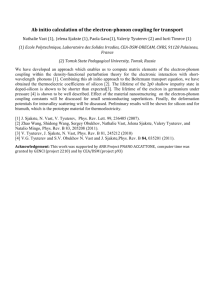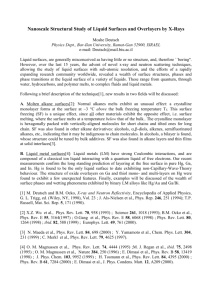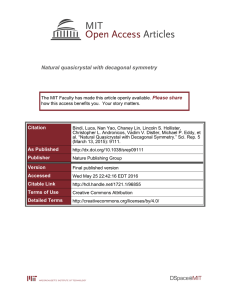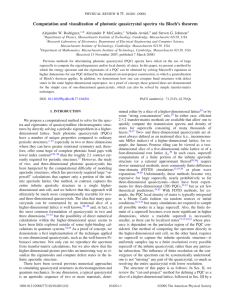Paper
advertisement
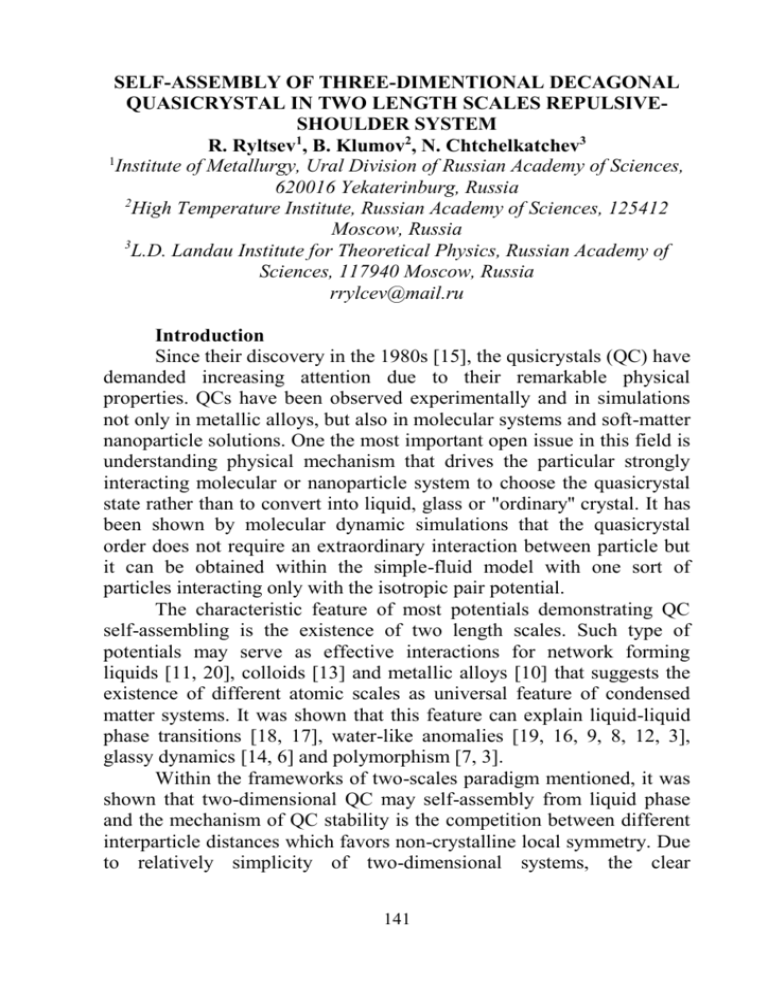
SELF-ASSEMBLY OF THREE-DIMENTIONAL DECAGONAL
QUASICRYSTAL IN TWO LENGTH SCALES REPULSIVESHOULDER SYSTEM
R. Ryltsev1, B. Klumov2, N. Chtchelkatchev3
1
Institute of Metallurgy, Ural Division of Russian Academy of Sciences,
620016 Yekaterinburg, Russia
2
High Temperature Institute, Russian Academy of Sciences, 125412
Moscow, Russia
3
L.D. Landau Institute for Theoretical Physics, Russian Academy of
Sciences, 117940 Moscow, Russia
rrylcev@mail.ru
Introduction
Since their discovery in the 1980s [15], the qusicrystals (QC) have
demanded increasing attention due to their remarkable physical
properties. QCs have been observed experimentally and in simulations
not only in metallic alloys, but also in molecular systems and soft-matter
nanoparticle solutions. One the most important open issue in this field is
understanding physical mechanism that drives the particular strongly
interacting molecular or nanoparticle system to choose the quasicrystal
state rather than to convert into liquid, glass or "ordinary'' crystal. It has
been shown by molecular dynamic simulations that the quasicrystal
order does not require an extraordinary interaction between particle but
it can be obtained within the simple-fluid model with one sort of
particles interacting only with the isotropic pair potential.
The characteristic feature of most potentials demonstrating QC
self-assembling is the existence of two length scales. Such type of
potentials may serve as effective interactions for network forming
liquids [11, 20], colloids [13] and metallic alloys [10] that suggests the
existence of different atomic scales as universal feature of condensed
matter systems. It was shown that this feature can explain liquid-liquid
phase transitions [18, 17], water-like anomalies [19, 16, 9, 8, 12, 3],
glassy dynamics [14, 6] and polymorphism [7, 3].
Within the frameworks of two-scales paradigm mentioned, it was
shown that two-dimensional QC may self-assembly from liquid phase
and the mechanism of QC stability is the competition between different
interparticle distances which favors non-crystalline local symmetry. Due
to relatively simplicity of two-dimensional systems, the clear
141
geometrical criteria for the formation of different types of QCs were
recently found [4, 1, 2].
The situation is different for three-dimensional case. First of all,
there is the only example of self-assembling of QC during the simulation
of 3D monatomic system with isotropic potential [5]. This potential has
two attractive wells separated by pronounced maximum and has been
specially constructed to encourage formation of icosahedral local order
by suppressing competing crystallographic configurations. So the partial
roles of two length scales competition and attractive part of the
interaction in QC formation is not clear in this case. Moreover, there are
no explanations of how this competition stabilizes 3D QC .
Here we show that attraction in the interaction potential is not
important and so the existence of two scales may be the sufficient
condition for QC formation. We investigate by the molecular dynamic
simulation one component three-dimensional system of particles
interacting via pure repulsive two length scales potential. We observe at
certain density-temperature domain the phase with three-dimensional
decagonal quasicrystal order at both the local and the medium scales.
This phase is self-assembled from liquid phase through first order phase
transition. We suggest that the underlined mechanism of 3D quasicrystal
formation is the stabilization of large icosahedral clusters due to the
existence of two effective atomic lengthes.
Simulation details
We investigate one component three-dimensional system of
particles interacting via repulsive two length scales potential by the
molecular dynamic simulation. We use the pair potential model of
"collapsing soft spheres":
U (r ) = nF 2k0 r 1 ,
(1)
r
where nF ( x) = 1/[1 exp ( x)] , - is the unit of energy, and 1 are
«hard»-core and «soft»-core diameters. We take here n = 14 , k0 = 10 ,
and 1 = 1.35 . These parameters values reveal complex system
n
behavior such as phase diagram with polymorphous transitions and
disordered gap, see Fig. 1, and water-like anomalies.
In the remainder of this paper we use the dimensionless quantities:
142
~
~
r r/ , U = U/ , temperature T = T/ , density ~ N 3 /V , and
~
time t = t/[ m/ ] , where m and V is the molecular mass and
system volume correspondingly. As we will only use these reduced
variables, we omit the tildes.
For MD simulations, we have used DL_POLY Molecular
Simulation Package developed at Daresbury Laboratory.
We have used the system of N = 5000 64000 particles that
were simulated under periodic boundary conditions in Nose-Hoover
NVT ensemble. The MD time step was t = 0.01 . It is nearly the
maximum possible time step that satisfies the energy conservation
condition. The system was studied in the density region of
(0.35 0.75) . At all densities of this region the system was cooled
in a stepwise manner from high temperature state and completely
equilibrated at each step. The time dependencies of temperature,
pressure and configuration energy were analyzed to control
equilibration. Data were subsequently collected during the time tsamp
that was chosen to be large enough to get good statistics for averaging.
Typically, tsamp was about 107 MD steps.
Local order analysis
To define the local structural properties of the system we use the
bond order parameter (BOP) method, which has been widely used in the
context of condensed matter physics, colloidal and complex plasmas,
granular media, etc. In this method the rotational invariants (RIs) of rank
l of both second ql (i) and third wl (i ) order are calculated for each
particle i in the system from the vectors (bonds) connecting its center
with the centers of its N nn (i ) nearest neighboring particles:
1/2
wl (i ) =
m =l
ql (i) = 4 (2l 1) | qlm (i) |2
m= l
l
l
l
m m m qlm1 (i )qlm2 (i )qlm3 (i ),
2
3
1
m1 , m2 , m3
m1 m2 m3 = 0
143
(2)
where qlm (i ) = N nn (i) 1
N nn ( i )
j =1
Ylm (rij ) , Ylm are the spherical harmonics
and rij = ri r j are vectors connecting centers of particle i and j . In
l
m1
Eq.(3)
l
m2
l
are the Wigner 3 j -symbols, and the summation
m3
in the latter expression is performed over all the indexes mi = l ,..., l
satisfying the condition m1 m2 m3 = 0 .
The big advantage of BOP is that any crystalline structure has a
unique set of the rotational invariants ql and wl . Here, to detect both
ordered (crystalline) and disordered (liquid-like) structures, we calculate
the rotational invariants q4 , q6 , w4 and w6 for each particle using the
fixed number of nearest neighbors N nn = 12 . A particle whose
coordinates in the 4-dimensional space (q4 , q6 , w4 , w6 ) are sufficiently
close to those of the ideal lattice (let's say, fcc) is counted as fcc-like
particle. By calculating the bond order parameters it is easy to identify
also disordered (liquid-like) phase (for instance, such particles have
liq
1/2
fcc/hcp/ico
mean bond order parameter q6 ; N nn ;0.29 = q6
). By varying
number of nearest neighbors (NN) N nn and rank l of bond order
parameter it is possible to identify any lattice type (including
quasicrystalline particles and distorted hcp/fcc/ico modifications, etc.)
existing in the system (e.g, by using N nn = 8 and 14 it is easily to
identify the first (NN) and the second (next nearest neighbors) shells of
the body centered cubic (bcc) lattices, etc).
Results
Recently, we reported that this system demonstrates excellent
glass-forming ability in the density range of ρ (0,51-0,74) [14]. Inside
this region, one can equilibrate supercooled liquid without crystallization
down to temperatures at which relaxation time becomes too large for
simulation. At ρ > 0,74, ρ < 0,46 system spontaneously crystalizes
whereupon supercooling below the melting line. But within the range of
0,46 < ρ 0,54 situation is more complicated: system undergoes phase
144
transition into some non-crystalline state. In Fig. 1 we show the density
dependence of the transition temperature Ttr ( ) in common with early
reported glass transition temperature Tg on the sketch of the phase
diagram obtained in Ref. [7]. It is important to note that the transition
line Ttr ( ) is restricted on the left and right sides by the spinodal line of
liquid-fcc equilibrium and by Tg ( ) curve respectively.
Let us discuss firstly the thermodynamic origin of this transition.
In Fig. 2, the set of time dependencies of configurational energy Ecfg at
T = 0.1 and different densities is shown. We see that the transition
under consideration is attended by sharp jump of average Ecfg which
occurs spontaneously at certain time t tr . Note that t tr has a pronounced
downtrend with increasing density. According to Ttr ( ) in Fig. 1,
Ecfg (t ) curves calculated at different points of T = 0.1 isotherm
correspond to different supercooling degree and so that behaviour of t tr
is expectable. Thus we see that, being supercooled below Ttr , system
stays in metastable state corresponding to supercooled liquid for some
time t < t tr . That suggests that the transition under debates is the first
order phase transition.
This transition is also accompanied by drastic changes of
structural properties. In Fig. 3, we show radial distribution functions
(RDF) and angular distribution functions (ADF) at ρ = 0,5 and two
temperatures which are slightly higher and slightly lower the transition
temperature. We see that both the ADF and RDF evolution reveal that
structure properties change essentially.
In order to understand that structural changes better, we have
performed the detailed local structure analysis based on bond
orientational order parameters ql , wl . One of the most effective ways to
qualitative investigation of local structure is the analysis of partial
distribution functions (PDF) of particles in the multi-dimensional space
{ql , wl } of these parameters.
145
Fig. 1: The density dependence of liquid-quasicrystal transition temperature
(stars). The squares correspond to quasi-equilibrium glass transition
temperature T g extracted from D(T) using the Vogel-Fulcher formula
(VF) (see [14]).
Fig. 2. The time dependencies of system configurational energy at T = 0.1 and
different densities.
146
Fig. 3. Radial distribution functions (RDF) (a) and angular distribution
functions (ADF) (b) at = 0.5 and two temperatures which are
slightly higher and slightly lower the transition temperature.
In Fig. 4 we show such PDF in two-dimentional q4 q6 space for
two system states which are the same as for Fig. 3. Three characteristic
point of this space corresponding to ideal close packed clusters such as
icosahedra (ico), hexagonal close packed (hcp) cluster and face-centered
cubic (fcc) one are also marked. We see from the picture that local order
of the system after the transition is strongly icosahedral.
147
Fig. 4. Local orientational order of the system. The 2D probability distribution
function (PDF) on the plane of bond order parameters q4 – q6 at different
and two temperatures which are slightly higher (left) and slightly lower
(right) the transition temperature. Insets show 1D PDFs versus ql and wl
(l = 4,6).
148
Thus we see that, below the transition temperature Ttr , the local
structure of the system is strongly icosahedral. In this connection, it is
impotent to understand how the ico-like clusters are distributed in space.
Such distributions for ρ = 0,5 are shown in Fig. 5. We see that, below the
Ttr . there is strong tendency to form ''tubes'' made of face-shared
icosahedra in that case. In the plane perpendicular to tube axes, we see
10-fold symmetry which is corresponds to decagonal quasicrystal. So
the transition observed is the first order liquid-quasicrystal transition.
Note that it is the first case than such transition is observed in threedimendional onecomponent system with purely repulsive pair potential.
Fig. 5. The typical snapshot of system particles in quasicrystal phase at = 0.5 ,
T = 0.1.
Summary
In summary, we investigate by the molecular dynamic simulation
one component three-dimensional system of particles interacting via
149
pure repulsive two length scales potential. We observe at certain densitytemperature domain the phase with three-dimensional decagonal
quasicrystal order at both the local and the medium scales. This phase is
self-assembled from liquid phase through first order phase transition.
We suggest that the underlined mechanism of 3D quasicrystal formation
is the stabilization of large icosahedral clusters due to the existence of
two effective atomic lengthes.
Acknowledgments
The work was supported by Russian Foundation for Basic
Research (grants 12-03-00757, 14-02-00359), Ural Branch of Russian
Academy of Sciences (RCP-14-P3) and Presidium of Russian Academy
of Sciences (program № 12-P-3-1013). We are grateful to Ural Branch
of Russian Academy of Sciences for the access to "Uran'' cluster.
1.
2.
3.
4.
5.
6.
7.
8.
9.
10.
11.
12.
References
K. Barkan, H.Diamant, R. Lifshitz, Phys. Rev. B, 83, 172201
(2011).
K. Barkan, M. Engel, Michael, R. Lifshitz, Controlled, Phys.
Rev. Lett., 113, 098304 (2014).
S.V. Buldyrev, G. Malescio, C.A. Angell, G.N. Prestipino,F.
Saija, H.E.Stanley, L. Xu, J. Phys. Cond. Matt., 21, 504106
(2009).
T. Dotera, T.Oshiro, P. Ziherl, Nature, 506 (7487), 208 (2014).
M. Dzugutov, Phys. Rev. Lett., 70, 2924 (1993).
M. Dzugutov, Phys. Rev. A, 46, R2984 (1992).
Yu. D Fomin, N.V. Gribova, V. N. Ryzhov, S.M. Stishov, D.
Frenkel, J. Chem. Phys., 129, 064512 (2008).
N.V. Gribova, Yu.D. Fomin, D. Frenkel, V.N. Ryzhov, Phys. Rev.
E, 79, 051202 (2009).
P. Kumar, S.V. Buldyrev, F. Sciortino, E. Zaccarelli, H. E.
Stanley, Phys. Rev. E, 72, 021501 (2005).
J.K.
Lee,
Interatomic
Potentials
and
Crystalline
Defects.Technical report, The Metallurgical Society of AIME,
Warrendale, PA, 1981.
O. Mishima, H.E. Stanley, Nature, 396, (6709), 329 (1998).
A.B. de Oliveira, G. Franzese, P.A. Netz, C. Marcia, J. Chem.
Phys., 128, 064901 (2008).
150
13.
14.
15.
16.
17.
18.
19.
20.
M. Rechtsman, F. Stillinger, S. Torquato, Phys. Rev. E, 73,
011406 (2006).
R.E. Ryltsev, H.M. Chtchelkatchev, V.N. Ryzhov, Phys. Rev.
Lett., 110, 025701 (2013).
D. Shechtman, I. Blech, D. Gratias, J.W. Cahn, Phys. Rev.
Lett., 53, 1951 (1984).
P. Vilaseca, G. Franzese, J. Non-Cryst. Sol., 357, 419 (2011).
L. Xu, S.V. Buldyrev, N. Giovambattista, C.A. Angell, H.E.
Stanley, J. Chem. Phys., 130 (2009).
L. Xu, I. Ehrenberg, S.V. Buldyrev, H.E. Stanley, J. Phys. Cond.
Matt., 18, S2239 (2006).
L. Xu, Limei, N. Giovambattista, S.V. Buldyrev, P.G.
Debenedetti, H.E. Stanley, J. Chem. Phys., 134 (2011).
Z. Yan, S.V. Buldyrev, P. Kumar, N. Giovambattista, H.E.
Stanley, Phys. Rev. E, 77, 042201 (2008).
151

